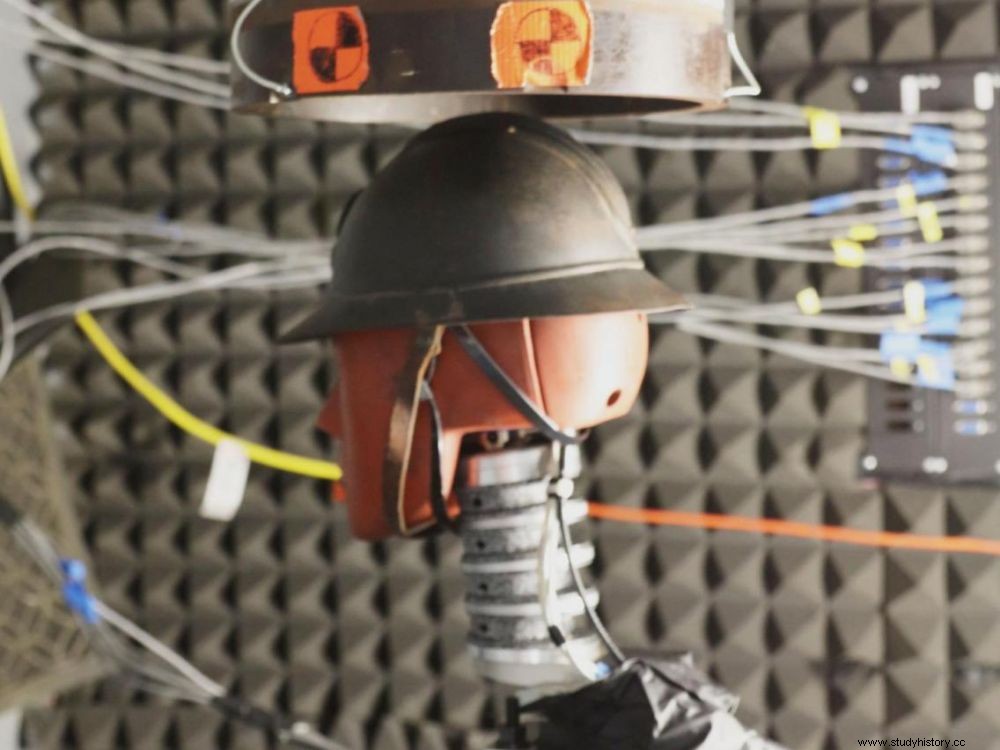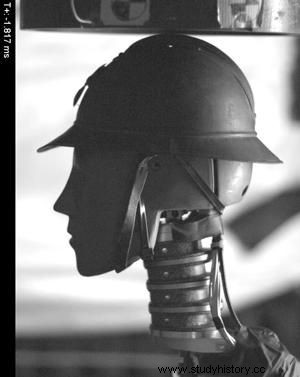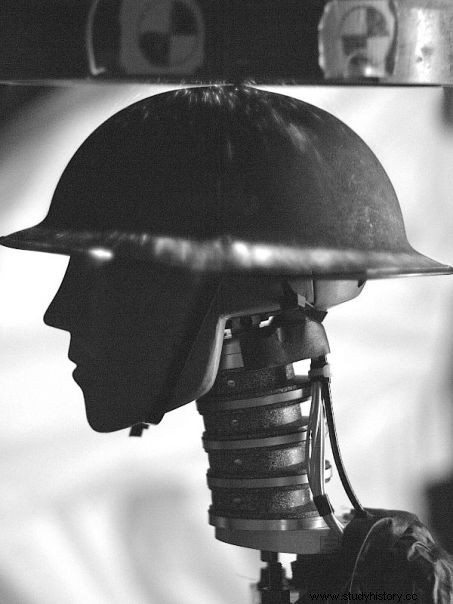The helmets used during the First World War were particularly effective in protecting soldiers against shock waves due to explosions. Enough to compete with contemporary helmets according to a new study.

A French World War I helmet sits under a 'shock tube'. This installation makes it possible to test how well it protects the dummy hit by a shock wave. The ridge down the center of the helmet was designed to deflect shrapnel, but may also have helped deflect the shock wave, allowing the helmet to outperform even modern combat helmets.
Despite their clever design to protect the military, modern helmets do not protect the brain from shock waves better than those used during the First World War (WWI), reveals a US study.
Four helmets tested with more or less powerful shock waves
At the start of the First World War in 1914, helmets were not part of the soldier's standard equipment. The head coverings were in fabrics like the French kepi or sometimes in leather. In 1915, France was the first country to equip its soldiers with steel helmets, saving many lives. The German helmet would not be deployed until 1916. "Several reports at the time estimated that at the start of the war, more than fifty percent of deaths were due to shrapnel, often hitting the head " , points out a study published on February 13, 2020 in the journal Plos One . Today, those who head the armed forces have changed a lot. They protect better against bullets but also against blunt impacts.
But do they also play their role during the explosions? In other words, do they effectively absorb shock waves? Engineers from Duke University in the United States conducted tests to find out for sure.
The engineers conducted their study on four different helmets:the one used during WWI by the Americans and the British (the Brodie), that of the French (the Adrian), the Germans (the Stahlhelm) and a modern helmet now used by the US military, the advanced combat helmet. The researchers took turns placing the helmets on the head of a dummy equipped with several pressure sensors, which was then placed under a shock tube, i.e. a tool capable of simulating an explosion and therefore its physical consequences.
The instrument was pressurized with helium until one wall of the membrane burst, releasing the gas in a shock wave. "The helmets were tested with shock waves of varying strength, each corresponding to a different type of German artillery shell exploding at a distance of one to five meters “, explains Duke University in a press release. The researchers were then able to translate the data collected in terms of the risk of brain damage.
Despite their clever design to protect the military, modern helmets do not protect the brain from shock waves better than those used during the First World War (WWI), reveals a US study.
Four helmets tested with more or less powerful shock waves
At the start of the First World War in 1914, helmets were not part of the soldier's standard equipment. The head coverings were in fabrics like the French kepi or sometimes in leather. In 1915, France was the first country to equip its soldiers with steel helmets, saving many lives. The German helmet would not be deployed until 1916. "Several reports at the time estimated that at the start of the war, more than fifty percent of deaths were due to shrapnel, often hitting the head " , points out a study published on February 13, 2020 in the journal Plos One . Today, those who head the armed forces have changed a lot. They protect better against bullets but also against blunt impacts.
But do they also play their role during the explosions? In other words, do they effectively absorb shock waves? Engineers from Duke University in the United States conducted tests to find out for sure.
The engineers conducted their study on four different helmets:the one used during WWI by the Americans and the British (the Brodie), that of the French (the Adrian), the Germans (the Stahlhelm) and a modern helmet now used by the US military, the advanced combat helmet. The researchers took turns placing the helmets on the head of a dummy equipped with several pressure sensors, which was then placed under a shock tube, i.e. a tool capable of simulating an explosion and therefore its physical consequences.
The instrument was pressurized with helium until one wall of the membrane burst, releasing the gas in a shock wave. "The helmets were tested with shock waves of varying strength, each corresponding to a different type of German artillery shell exploding at a distance of one to five meters “, explains Duke University in a press release. The researchers were then able to translate the data collected in terms of the risk of brain damage.

A French First World War helmet subjected to a shock wave reproducing the power of German shells. © Joost Op 't Eynde, Duke University

A Brodie helmet used by American and British forces during the First World War hit in turn by a shock wave. © Joost Op 't Eynde, Duke University
The French helmet was particularly effective against explosions
All helmets tested reduced the risk of moderate brain bleeds by five to ten times. When testing with the Adrian helmet, the risk was even lower. "While we found that all helmets provided substantial blast protection, we were surprised to find that century-old helmets performed as well as modern helmets , comments Joost Op 't Eynde co-author of the study. Some historical helmets have sometimes even performed better ". Within a certain limit, the helmet that equipped the French troops was the most effective:according to these tests, it limited the pressure at the top of the skull compared to other helmets, even the most modern.
"The result is intriguing as the French helmet was made with similar materials to its German and British counterparts, and even had a thinner wall, notes Mr. Eynde. The main difference is that the French helmet had a crest at the top. Although it was designed to deflect shrapnel, this feature could also have deflected shock waves " towards the side of the head. The crest also provides an additional first layer for the reflection of shock waves before they are reflected a second time on the helmet itself, underlines the study.
However, although the Adrian helmet provides superior protection "against blasts to the crown of the head " (in the case of airbursts therefore), "the ballistic protection it provided was inferior to both the Brodie and Stahlhelm helmet ".
Explosions no longer aerial but lateral
For the researchers, this work shows that simple structural characteristics should be able to improve the capabilities of helmets in the face of shock waves. However, this study has a limitation. The scenario of an aerial bombardment is consistent with the First World War but less so with modern conflicts. Explosions still injure soldiers in theaters of armed conflict such as Iraq or Afghanistan, but they are different from those experienced on the battlefields of 1914. Today, soldiers are confronted with improvised explosive devices (or IED) hidden on the side of the roads. The impact is then lateral. Nevertheless, the finding of the study remains valid:the upper part of the helmets used today visibly have a weakness. Their Achilles heel in a way.
